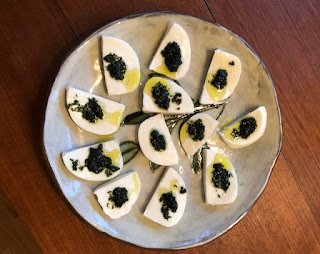Chicken Stir-fried with Cashews or Peanuts
This is one of the first recipes I taught in the 1970s when my family and I returned to the US from years in Malaysia. It’s an ancestrally Chinese dish that was common in Malaysia, but was also frequent in urban Thai and other Southeast Asian cuisines.
This is a richer dish than an ordinary stir
fry of chicken with vegetables and cashews. At fancy restaurants in Asia it is
sometimes served in a crispy “bird’s
nest” of fried shredded taro.
The recipe serves six, with rice.
2 pounds boneless skinless breasts
Juice from 1 tablespoon of grated fresh ginger (no need to
peel)
1 tablespoon soy sauce
2 teaspoons cornstarch
1/4 teaspoon salt
3/4 cup snow peas or broccoli pieces
1 sweet red chili pepper or 1/4 of a large red bell pepper
3/4 cup cashews, dry-roasted (peanuts can be substituted)
3/4 cup sunflower or canola oil, plus more if needed
Sauce:
1 1/2 tablespoons soy sauce
2 1/2 teaspoons sweet bean paste or hoi sin sauce (both
available at Asian groceries),
1 tablespoon rice wine, sake, or dry sherry
1 teaspoon rice or white vinegar
4 1/2 tablespoons water
1 tablespoon sugar
1 teaspoon cornstarch
1/2 teaspoon Asian sesame oil (available at Asian groceries)
Trim off any tough or fatty parts of the chicken and cut
flesh into 1/2 by 1-inch pieces. Grate ginger and press out the juice with a
garlic press or twist it in a moistened corner of dish towel and squeeze it to
express the juice. Add ginger juice to chicken, along with 1 tablespoon of soy
sauce, 2 teaspoons of cornstarch, plus the salt. Mix well and let marinate at
least 10 minutes, stirring occasionally.
If using snow peas, remove their stems and tips and pull off
any tough strings from the peas. Cut peas in half on a sharp diagonal. If using
broccoli, cut the pieces lengthwise into tiny flowerets about 1/2 inch on the
top. Slice pepper in 1/4-inch strips, 1-1/2 inches long. Mix the sauce
ingredients in a bowl.
In wok or large frying pan, heat oil to moderately hot.
Quickly pre-fry chicken, half at a time, stirring frequently, about 2 minutes,
or until the edges begin to turn slightly brown. Lift chicken out of the oil
and place in a bowl.
When chicken has been pre-fried, pour off all except 2 tablespoons of the oil (save it for other meat cooking.). Heat pan and add the pre-fried chicken. Stir and fry until just hot. Stir sauce mixture to “dissolve” the cornstarch, and add it to the pan. Stir and fry until sauce comes to a boil and thickens. Add snow peas or broccoli and pepper and bring back just to a boil. Boil for 1 minute, stirring. Taste sauce and add salt if necessary. Stir in most of the cashews (or peanuts). Serve on a platter. Sprinkle with remaining nuts.






.jpg)
.jpg)



